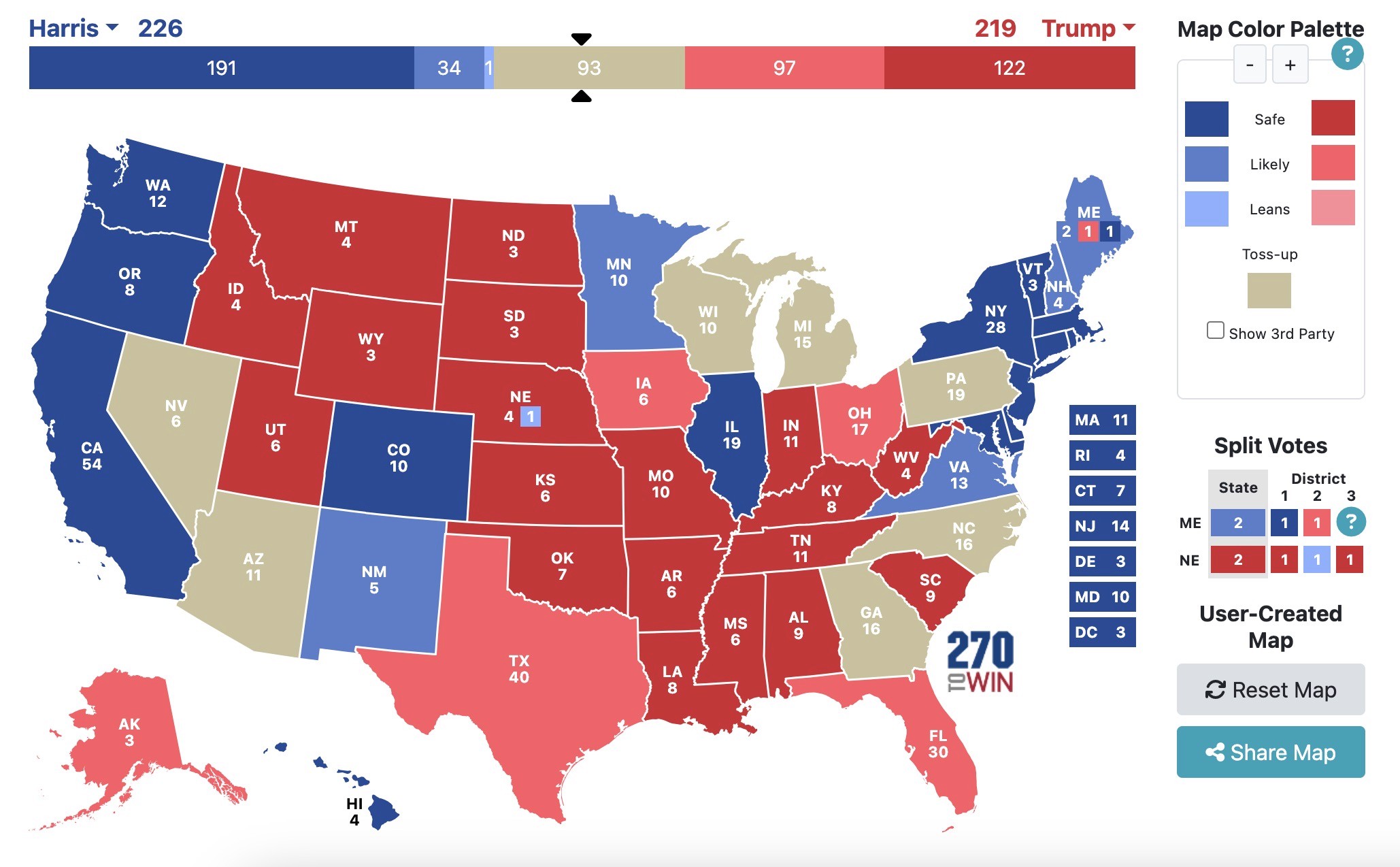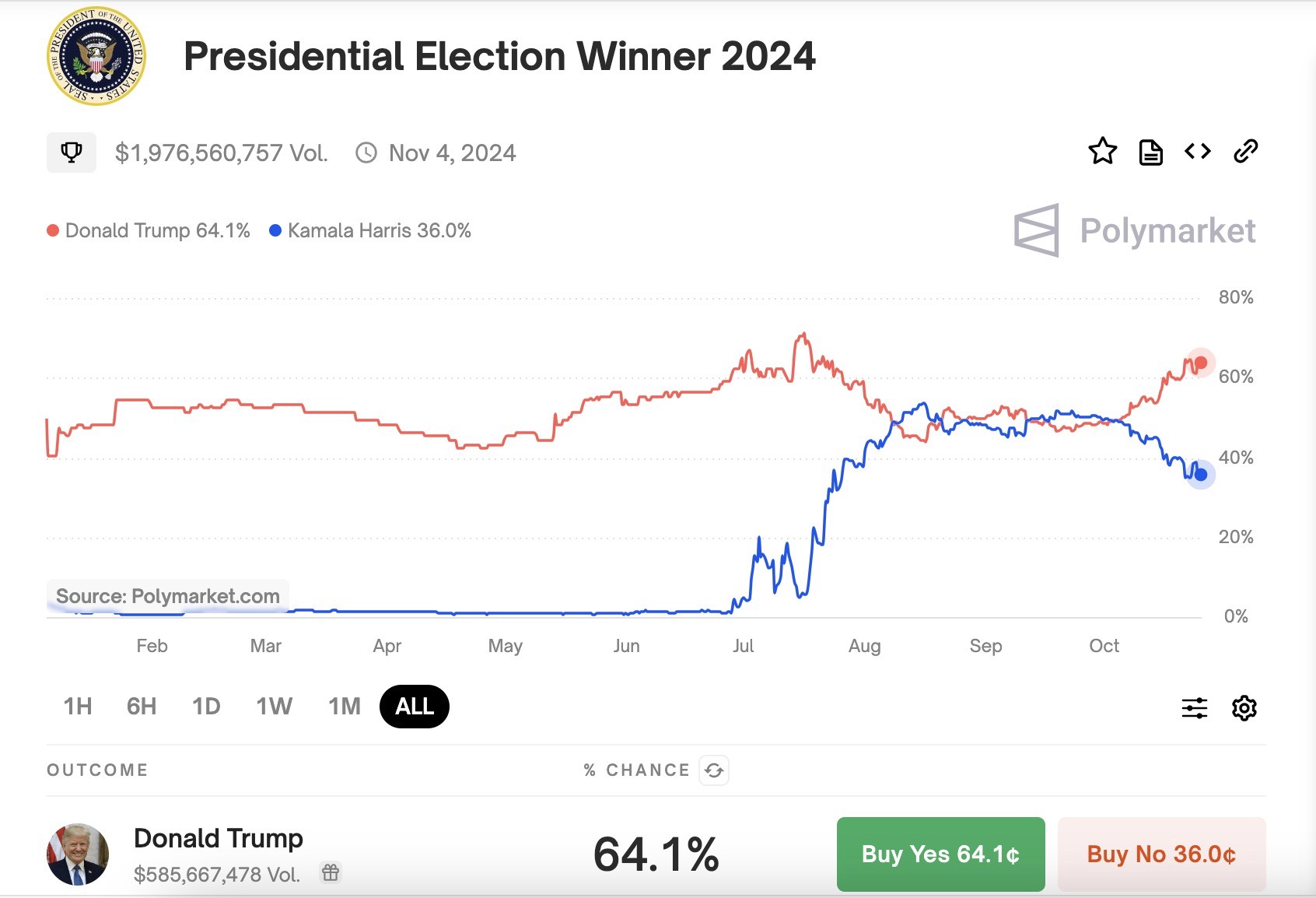2024 U.S. Presidential Election: Final Forecast Update as of October 25
Oct 25, 2024
Bill W. - As Election Day nears, last-minute developments in key battleground states and shifts in polling and betting markets reveal the stakes of an intensely polarized election between Harris and Trump.

Election Day Countdown: New Twists and Turning Points
With the impending 2024 presidential election in the United States, the race has seen a series of unexpected twists and rising scrutiny over battleground states. One such focal point that has emerged is Springfield, Ohio, where the recent unprecedented interest on a national level in the city is quite remarkable. This quiet, out-of-the-way area has grown into a rally and political event hotbed- a perfect example of how this election is focusing on smaller American towns. Meanwhile, Trump's populist appearance-epitomized most vividly by his now-viral stunt of "working" a shift at McDonald's-has furthered his image as the man of the people in reaching out to working-class voters. These light moments are centrally prepared to illustrate how both candidates are using unique strategies to reach out to the electorate for those last-minute votes.
Battleground States Harris's Gains and Republican Urgency
Since Harris took Biden's place as the Democratic candidate, her campaign has been fairly strong in securing Democratic strongholds and rallying her base. The Republican Party has also taken steps it feels are necessary to blunt her gains, however, especially in key battleground states that are becoming more hotly contested with each passing day. The seven states at the center of the electoral fight are Wisconsin, Michigan, Pennsylvania, North Carolina, Georgia, Nevada, and Arizona.

Each state possesses considerable potential to influence the final outcome, characterized by distinct developments that have altered the landscape:
Wisconsin and Michigan: Early successes in the Rust Belt state were pivotal, in great part due to Senator Harris's robust outreach effort in the Midwest, garnering support for her economic and social policy positions. However, a recent surge in Republican activity generated considerable competition. In particular, Wisconsin has been seen to shift toward rural voters returning to support Trump based on apprehensions about Harris's lack of midwestern origins and the Democratic Party management of critical local issues.
North Carolina: Coming into election season, it seemed a complete and utter cinch for Democrats. But in recent times, it has been torrid. Neo-Nazi remarks by the Republican candidate stirred an outcry, but Trump's move to provide hurricane relief in the state made up some lost ground for the GOP. Still, Harris has weighed in with support for communities affected by disaster, and the mix of controversy and disaster response has kept this race volatile, with polls showing a slight Republican edge.
Georgia and Nevada: Harris's large investment in mobilizing the minority communities and Democratic-leaning voters gave her a slim lead in Georgia and Nevada. However, Trump's appeal to the state's economic concerns, especially on energy and job creation, kept his support strong. Both states remain toss-ups as of late October with daily fluctuations in polling data.
Arizona: The ever-changing demographics in Arizona have turned it into one of the fiercely contested states with varied positions on immigration, public health, and economic issues of the candidates, which continue to divide the voters. Harris's attempt at reaching out to suburban and Latino communities has earned her some favor, but Trump's stern policies attract the rural and conservative base, making the state still unpredictable.
Recent Developments in Betting and Polling: A Transition in Favor of Trump
With Election Day rapidly approaching, both the betting markets and polling data continue to move in the direction of an apparent Trump lead. According to Polymarket, one of the most well-known betting markets, Trump's probability stands at 64.1%, which saw its most significant move above the "golden cross" at the beginning of October. Thus, this chart would indicate growing confidence among those betting that recent developments have given an advantage to Trump.

Meanwhile, the FiveThirtyEight polling update from October 25 suggests that Trump currently leads in three key states: North Carolina, Arizona, and Georgia. The remaining four battleground states, Wisconsin, Michigan, Pennsylvania, and Nevada, which had previously favored Democrats, are now tied. This is serious movement because Harris's once-clear advantages in these states have dissipated over the past few weeks, increasing the possibility of these states continuing on a pro-Trump trend.

Trump's Path to a Possibly Historic Win
If Trump continues this upward momentum in the battleground states, a realistic path opens for him toward a significant Electoral College victory. The seven contested states are Wisconsin, Michigan, Pennsylvania, North Carolina, Georgia, Nevada, and Arizona; if Trump were to win all these states, he could achieve an Electoral College margin of 312-226. That would be an unprecedented comeback, building on late-stage polling gains and tapping Republican support across both the Rust Belt and Sun Belt regions.

Everything depends on whether Trump can maintain the current level of support and generate high voter turnout among conservatives and independents, particularly in rural and suburban areas.
A victory of this nature would underpin his continued strong influence among the Republican base and, of course, the efficiency of his populist, anti-establishment rhetoric. This may, however, be contingent upon voter turnout, any last-minute fluctuations in undecided voters, and sustained focus on economic and cultural issues that appeal to his base.
But overall, I think the odds of this happening are very high. Judging by Harris's poor performance in Forbes News and the high level of interest in economic and security issues among middle-of-the-road voters, there is a very high probability that Trump will landslide all the swing states, which would also bring about a possible Republican control of the White House + Senate + House of Representatives in a super-government. If this happens, Trump will be able to continue to renew the MAGA movement and gain unprecedented popularity within the Republican Party, and he will have very few constraints on his behavior in the White House.
Down-Ballot Implications: The Stakes in Congress Races
The presidential race significantly influences crucial Senate and House races across the country as the repercussions for down-ballot candidates become apparent in a number of closely watched contests.
Ohio Senate Race: The Republican Senate candidate, Moreno, from Ohio, apparently is experiencing what many in the polling industry would refer to as a "golden cross," where there is growing momentum and support for his cause. That's important in a state where Democrats had the distinct advantage in the past, but recent gains by the GOP might signal that Republicans could take this seat and continue building their power in Congress.
The races in the Senate from Wisconsin and Pennsylvania are exhibiting unexpectedly increased closeness, with much of the results falling within the margin of error. Once-Democratic-leaning Wisconsin shows signs of shifting as the impact of Trump trickles down to the support for the downticket Republican. Similarly, the Senate race in Pennsylvania has gone competitive, with both the in-state and national issues weighing heavily on voters' preferences. These Senate and House races are important because they will set which party holds Congress and helps shape legislative priorities for the next four years. Republican gains in these seats would provide substantial leverage for a Trump administration, while Democratic wins would strengthen Harris's ability to implement her policy agenda.
Conclusion
With Election Day looming, the 2024 Race for the White House is shaping up to be one of the most aggressive and unpredictable electoral contests in recent history. Harris and Trump have sought various ways to engage voters in the battleground states, each dependent on specific issues and regional advantages. While Harris's rise as a formidable Democratic candidate initially complicated things for the Republican Party, the late-stage momentum by Trump-regional advantages in critical swing states, especially, has turned the scales in his direction. In fact, the final days of this campaign will be very important, as both candidates pull out all the stops to lock in support and motivate people to vote. A 312-226 Electoral College win for Trump remains very possible, if current trends hold up; but Harris's solid work in the Sun Belt and Rust Belt has kept this contest tight. Senate and House down-ballot races are just as important, as they will shape the future of Congress and impact either administration's capacity to govern effectively. In full view of the world, this election result will decide not just who the next president of America will be but will also redefine priorities for the United States in domestic and foreign policies. Each candidate has a very different vision to take the country forward, and as the countdown goes on, the stakes could never be higher. The way the election goes may set the stage for a new chapter in American politics-one that would extend Trump's legacy or another that ushers in the historic Harris administration.